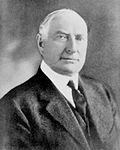November 2, 1920 | ||||||||||||||||||||||||||||||||||
34 of the 96 seats in the United States Senate 49 seats needed for a majority | ||||||||||||||||||||||||||||||||||
|---|---|---|---|---|---|---|---|---|---|---|---|---|---|---|---|---|---|---|---|---|---|---|---|---|---|---|---|---|---|---|---|---|---|---|
| ||||||||||||||||||||||||||||||||||
 Results of the elections: Democratic hold Republican gain Republican hold No election | ||||||||||||||||||||||||||||||||||
| ||||||||||||||||||||||||||||||||||
The 1920 United States Senate elections were elections for the United States Senate that coincided with the presidential election of Warren G. Harding. The 32 seats of Class 3 were contested in regular elections, and special elections were held to fill vacancies. Democrat Woodrow Wilson's unpopularity allowed Republicans to win races across the country, winning ten seats from the Democrats and providing them with an overwhelming 59-to-37 majority. The Republican landslide was so vast that Democrats lost over half of the contested seats this year and failed to win a single race outside the South. In fact, this is the most recent occasion where every race decided by under 10 points all voted for the same party, showcasing the sheer strength of Republicans' performance in this election.
Contents
- Gains, losses, and holds
- Retirements
- Defeats
- Post-election changes
- Change in composition
- Before the elections
- Election results
- Race summary
- Special elections during the 66th Congress
- Elections leading to the 67th Congress
- Closest races
- Alabama
- Alabama (regular)
- Alabama (special)
- Arizona
- Arkansas
- California
- Colorado
- Connecticut
- Florida
- Georgia
- Idaho
- Illinois
- Indiana
- Iowa
- Kansas
- Kentucky
- Louisiana
- Maryland
- Missouri
- Nevada
- New Hampshire
- New York
- North Carolina
- North Dakota
- Ohio
- Oklahoma
- Oregon
- Pennsylvania
- South Carolina
- South Dakota
- Utah
- Vermont
- Virginia (special)
- Washington
- Wisconsin
- See also
- Notes
- References
- Further reading
Since the passage of the Seventeenth Amendment, these elections were the closest in which the winning party in almost every Senate election mirrored the winning party for their state in the presidential election, with Kentucky being the only Senate race not to mirror their presidential result. No other Senate election cycle in a presidential year would come close to repeating this feat until 2016, in which the result of every Senate race mirrored the corresponding state's result in the presidential election. Coincidentally, that election cycle involved the same class of Senate seats, Class 3. [1] This is also one of only five occasions where 10 or more Senate seats changed party in an election, with the other occasions being in 1932, 1946, 1958, and 1980.
As of 2025 [update] , the 59 seats held after this election cycle remains the highest number of seats that the Republican Party has held as the result of an election cycle. This number rose to 60, the highest number of seats the Republicans have ever held, after Democrat senator Josiah O. Wolcott of Delaware accepted an offer from Republican governor William D. Denney to become Chancellor of the Delaware Court of Chancery, allowing Denney to name Republican T. Coleman du Pont to replace Wolcott, a seat du Pont held until the next election, in which both a special election was held for the remainder of the term and a regular election was held as the seat was normally up then, both of which du Pont lost narrowly to Democrat Thomas F. Bayard Jr. In addition, the 22-seat majority is the largest majority that the Republicans have achieved in any election since.


































































































